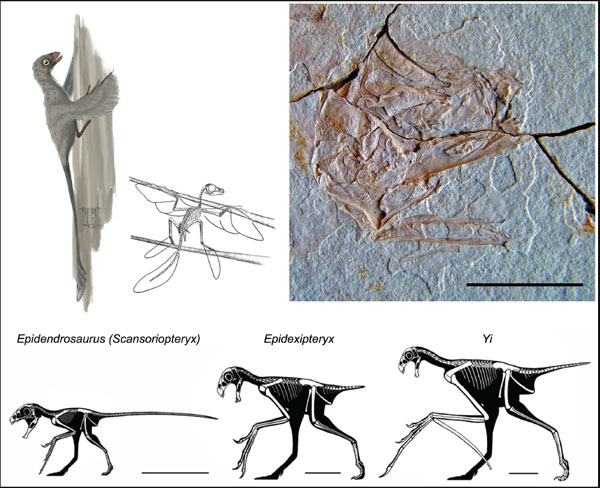Fig. (1) Reconstruction of Scansoriopteryx (=Epidendrosaurus), upper left, as a trunk-climbing glider; subsequent study of the specimen using Keyence microscopy showed hind-limb wings, providing new evidence for tetrapteryx gliding (see inset sketch by S. A. Czerkas). Lower, reconstructions of currently known scansoriopterids as terrestrial cursors, a reconstruction that is highly improbable and dictated by attempts to “accommodate the cladograms” indicating direct “dinosaur’ descendancy. Their pelves are not adapted for cursorial habits and in Scansoriopteryx the acetabulum is nearly closed, with no supra-acetabular crest. The femur, too, is not that of a bipedal cursor [see 18]. The other genera are quite similar in pelvic anatomy. Upper right, Digital Keyence image of the skull of Scansoriopteryx, similar to oviraptorosaurids, which is not that of a dinosaur, and the teeth are, like those of Epidexipteryx and Yi, simple peg-like teeth constricted at the base, similar to those of oviraptorosaurs and Mesozoic birds. Scansoriopteryx, upper left, reconstruction . . . By Matt Martyniuk, 2011 [CC: (http://creativecommons.org/licenses/by/3.0)], via Wikimedia Commons. Digital Keyence microscopy [see 18] image of skull, counterslab, courtesy Stephen A. and Sylvia J. Czerkas; copyright Stephen A. Czerkas; Institute of Geology, Chinese Academy of Sciences, CAGS02-IG-gausa-1/DM 607. Lower, left to right, reconstructions of Epidendrosaurus (=Scansoriopteryx), Epidexipteryx, and Yi, by Lida Xing, in: Padian, K. [26]; Reprinted by permission from Macmillan Publishers Ltd: Nature. Padian K. Dinosaur up in the air. Nature (News and Views) 2015; doi:10.1038/nature14392 (copyright 2015). Scale bars: skull, 1 cm; lower images, 5 cm.


